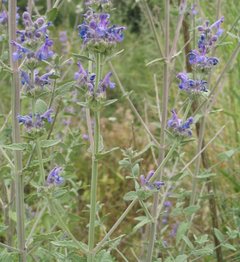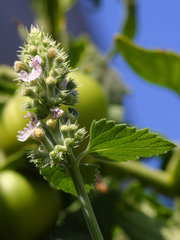

Custom Search
|
|
?
Nepeta |
||||||||||||
|---|---|---|---|---|---|---|---|---|---|---|---|---|

Nepeta curviflora
|
||||||||||||
| Scientific classification | ||||||||||||
|
||||||||||||
|
Species
|
||||||||||||
|
See text.
|
Nepeta is a genus of about 250 species of flowering plants in the family Lamiaceae. The members of this family are known as catnips or catmints.
The genus is native to Europe, Asia and Africa, with the highest species diversity in the Mediterranean region east to China. Most of the species are herbaceous perennial plants, but some are annuals. They have sturdy stems with opposite heart-shaped, green to greyish-green leaves. The flowers are white, blue, pink or lilac and occur in several clusters toward the tip of the stems.
 Nepeta cataria flowers
Nepeta cataria flowers
Nepeta cataria (Catnip, True Catnip, Catmint or Field Balm) is a 50100 cm tall herb resembling mint in appearance, with greyish-green leaves; the flowers are white, finely spotted with purple. It has been introduced to many countries, and is now a widespread weed in some areas, including the United States. A lemon-scented cultivar, N. cataria 'Citriodora' looks exactly like true catnip, but has the scent of, and can be used like Lemon balm.
Nepeta grandiflora (Giant Catmint or Caucasus Catmint) is lusher than true catnip, and has dark green leaves and dark blue, almost purple flowers.
Nepeta faassenii (N. racemosa N. nepetella; Faassen's Nepeta or Faassen's Catnip) is mostly grown as an ornamental plant. This hybrid is far smaller than either of above, and is almost a ground cover. It has with greyish-green leaves and light purple flowers.
Some Dracocephalum, Glechoma and Calamintha species were formerly classified in Nepeta.
Catnip and catmints are mainly known for, and named after, the effects they have on cats, particularly domestic cats. Approximately two thirds of cats are susceptible to the effects of catnip, as the phenomenon is hereditary.
Catnip contains nepetalactone, a terpene, that is thought to mimic feline sex pheromones. Cats detect it through their vomeronasal organs. When cats sense the bruised leaves or stems of catnip, they will rub in it, roll over it, paw at it, chew it, lick it, leap about, then purr loudly, growl, and meow. This reaction only lasts for several minutes before the cat loses interest. It takes up to two hours for the cat to reset and then it can come back to the catnip and have the same response as before. Young kittens and older cats are less likely to have a reaction to catnip but big cats, such as tigers, seem to be extremely sensitive to it.
Cat owners do not need to worry about allowing their cats access to catnip because there are, for the most part, no negative side effects to it. However, some cats become overly excited when exposed to catnip, and so aging cats with heart troubles should not be given catnip.
Other plants that also have this effect on cats include Valerian and plants that contain actinidine or dihydroactinidiolide (Smith, 2005).
At least three species attract cats, Nepeta cataria, N. grandiflora and N. faassenii, but most other species have not been tested. Of these, both true catnip and Faassen's catnip have a sharp, biting taste, while the taste of giant catmint is bland.
Cats, made by MultiMedia | Free content and software
This guide is licensed under the GNU Free Documentation License. It uses material from the Wikipedia.